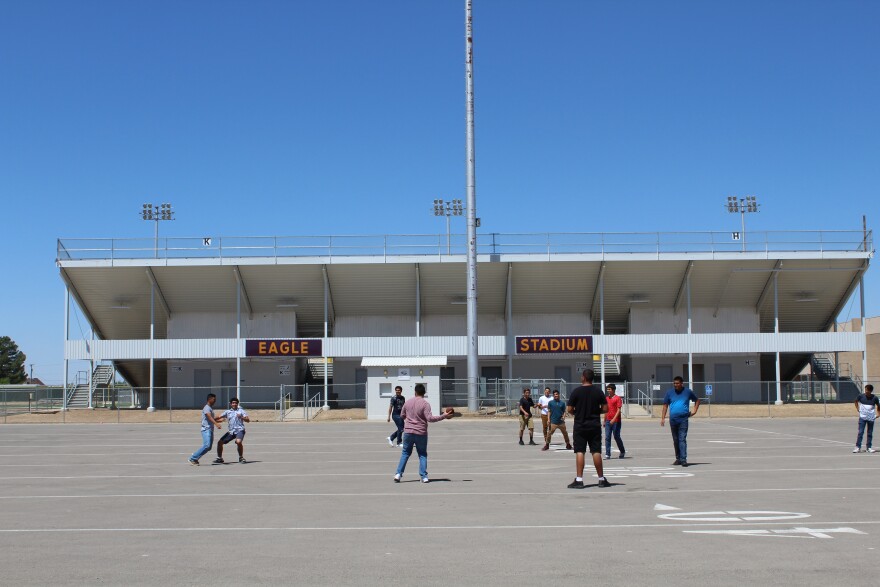Every year, the state of Texas and local school districts pay more and more for public education. Together, they’ll spend a projected $46 billion on Texas schools in 2017. That money comes from two main places: the state government and local property taxes. But that burden isn’t shared equally.
'Things are frozen in time'
Last year, the Texas Supreme Court called the funding system “Byzantine” and urged legislators to work on “transformational, top-to-bottom reforms that amount to more than Band-Aid on top of Band-Aid.” That seems to be the push lawmakers needed to take school funding seriously in 2017.
As the state’s share of the school funding pie chart continues to decline, listener Angela Greca wondered: Why do our property taxes go up every year, but the amount that the state spends per student does not?
Greca works with bilingual students at Richardson ISD, just outside of Dallas, and has two kids in the school district. Her daughter was diagnosed with dyslexia last year and gets extra help in the classroom. She’s concerned that special programs like the one her daughter’s in will be the first to go if the state doesn’t increase its spending.

Why doesn’t the state spend more? According to Chandra Villanueva at the Center for Public Policy Priorities in Austin, the simple answer is they’re just following the formula.
“What we’ve been seeing happening is that our school finance formulas aren’t adjusted for things like inflation and rising property values across the state. So it’s almost like things are frozen in time,” Villanueva said.
Over time, according to State Rep. Dan Huberty, we’ve let rising local property tax revenue fill in that gap created by the formulas.
“And so we basically, we’ve shifted the cost for funding of education from the state to the locals,” Huberty said on the House floor last month.
Why do our property taxes go up every year, but the amount that the state spends per student does not?
'It seems contradictory'
That’s why even school districts that generate a lot of property tax revenue, like Pecos-Barstow-Toyah ISD, are struggling. Pecos is home to about 8,000 residents, with 2,500 kids in the school district. The area has a couple of claims to fame: the Pecos Cantaloupe, the world’s first rodeo, and, according to district superintendent Jim Haley, some of the best barbecue in the state. Oh, and oil. Lots of it.
Haley says that since the ‘90s, petroleum has been the main industry in Pecos. And in the eyes of Texas lawmakers, his district is property wealthy – that means that the amount of property tax revenue the district brings in per student is above average. That’s largely thanks to the oil and gas reserves that the district sits on – literally. They’re being drilled out from directly beneath the high school campus.
“It seems contradictory,” he said, “but even though we are property rich and there’s a lot of oil and gas money being made, not all of the families are plugged into that. We have about 65 percent of families are on free and reduced lunch, meaning they’re close to the poverty level.”

According to Haley, only 15 percent of tax revenue in Pecos is paid by local homeowners and small business owners. The remaining 85 percent comes from the oil industry. While this might seem like a lucky break for a district like Pecos, of the $40 million they raise a year in tax revenue, they keep only $19 million, less than half. The rest is absorbed by the state and redistributed to property-poor districts, through a process called "recapture."
Teachers are spending out of pocket for supplies
As property values in the state of Texas increase, the number of districts that owe recapture is on the rise. This is how Texas tries to keep school funding fair. Some parents, like Stacie Fowlkes, have a hard time seeing it like that.
“As a teacher and a parent and a taxpayer, it’s frustrating when all of that money is taken out for your child and then it’s not used for the children in the district,” she said.
Fowlkes is a special education teacher and parent of two at Pecos ISD. She and her coworkers are wearing shirts they designed online that say “Straight Outta Room 29,” a nod to the N.W.A. album, and the room where their third graders come for extra help. They’re used to spending money out of pocket for school supplies, even for basic classroom needs.

“If you see a teacher at Walmart, you know they’re probably not shopping for their families,” Fowlkes said. “They’re shopping for the kids at school.”
With the current funding formula, even property-rich Pecos ISD is operating at an almost $3 million deficit. Next year, they’ll eliminate 17 teaching positions from the budget, which means increased class sizes. All this has parents and teachers not too happy about the whole recapture thing.
Chandra Villanueva says it’s unfortunate that recapture has gotten a bad rap. She says recapture is actually doing exactly what it was designed to do: improve equity between districts.
She thinks upping how much the state spends is the real solution.

“Districts are writing a check to the state; they see exactly how much they pay in recapture. It’s harder for parents in districts to say, 'well if this part of the formula was changed, we’d be in a better position,'” she said.
Superintendent Haley is optimistic. He says, this session, lawmakers seem serious about making that formula change. Representative Huberty sponsored a massive education funding overhaul that passed the House last month. It’s one of several bills being considered this session aimed at simplifying and modernizing how Texas funds its schools. If Huberty’s bill makes it to the Governor’s desk, it would provide Texas’s public schools with an extra $1.6 billion.
This feature was produced as part of Texas Decides, a series produced in cooperation with the Texas Station Collaborative.





